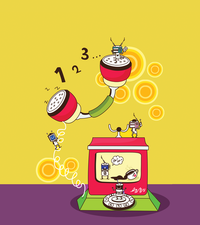Create a flyer with the free Scribus desktop publishing software
Party Alert!

Linux comes with Scribus, a comprehensive desktop publishing program that can help you create a flyer with a professional layout.
The Apple Mac is still commonly regarded as a tool of choice for creative professionals in the design business. Linux, however, includes a comprehensive and free toolbox that gives you a workable and even convenient option for creating professional layouts. To show how simple this can be, I look at how to design a flyer for a party invitation.
The obvious choice of tool for this task is Scribus [1], the layout program, complemented by GIMP [2] for editing photos and other images. If necessary, Inkscape [3] completes your toolkit if you want to create your own vector graphics or edit third-party graphics. You don't need expensive hardware and even more expensive licenses for commercial software: These three tools can be found in the repositories of all the major distributions, so you can easily install them using your package manager.
Structure
A typical flyer is fairly concise – usually letter-sized (A4 or DIN) or postcard-sized, with color printing on both sides. In contrast to business advertising and informal flyers, a party flyer can and should be colorful. However, you should consider where you will be distributing the flyer: If it will be competing with many other colorful printed works, a more subtle or unobtrusive color scheme might attract more attention.
[...]
Buy this article as PDF
(incl. VAT)
Buy Linux Magazine
Subscribe to our Linux Newsletters
Find Linux and Open Source Jobs
Subscribe to our ADMIN Newsletters
Support Our Work
Linux Magazine content is made possible with support from readers like you. Please consider contributing when you’ve found an article to be beneficial.

News
-
Two New Distros Adopt Enlightenment
MX Moksha and AV Linux 25 join ranks with Bodhi Linux and embrace the Enlightenment desktop.
-
Solus Linux 4.8 Removes Python 2
Solus Linux 4.8 has been released with the latest Linux kernel, updated desktops, and a key removal.
-
Zorin OS 18 Hits over a Million Downloads
If you doubt Linux isn't gaining popularity, you only have to look at Zorin OS's download numbers.
-
TUXEDO Computers Scraps Snapdragon X1E-Based Laptop
Due to issues with a Snapdragon CPU, TUXEDO Computers has cancelled its plans to release a laptop based on this elite hardware.
-
Debian Unleashes Debian Libre Live
Debian Libre Live keeps your machine free of proprietary software.
-
Valve Announces Pending Release of Steam Machine
Shout it to the heavens: Steam Machine, powered by Linux, is set to arrive in 2026.
-
Happy Birthday, ADMIN Magazine!
ADMIN is celebrating its 15th anniversary with issue #90.
-
Another Linux Malware Discovered
Russian hackers use Hyper-V to hide malware within Linux virtual machines.
-
TUXEDO Computers Announces a New InfinityBook
TUXEDO Computers is at it again with a new InfinityBook that will meet your professional and gaming needs.
-
SUSE Dives into the Agentic AI Pool
SUSE becomes the first open source company to adopt agentic AI with SUSE Enterprise Linux 16.

